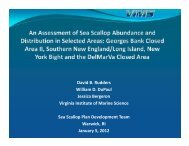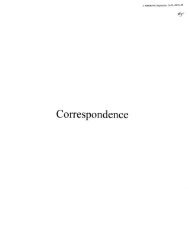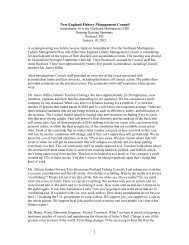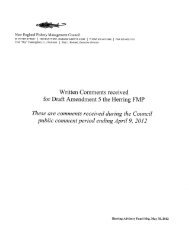Smooth Bottom Net Trawl Fishing Gear Effect on - New England ...
Smooth Bottom Net Trawl Fishing Gear Effect on - New England ...
Smooth Bottom Net Trawl Fishing Gear Effect on - New England ...
You also want an ePaper? Increase the reach of your titles
YUMPU automatically turns print PDFs into web optimized ePapers that Google loves.
NOAA/NMFS Unallied Science Project, Cooperative Agreement NA16FL2264 December 2005<br />
<str<strong>on</strong>g>Smooth</str<strong>on</strong>g> <str<strong>on</strong>g>Bottom</str<strong>on</strong>g> <str<strong>on</strong>g>Net</str<strong>on</strong>g> <str<strong>on</strong>g>Trawl</str<strong>on</strong>g> <str<strong>on</strong>g>Fishing</str<strong>on</strong>g> <str<strong>on</strong>g>Gear</str<strong>on</strong>g> <str<strong>on</strong>g>Effect</str<strong>on</strong>g> <strong>on</strong> the Seabed:<br />
Investigati<strong>on</strong> of Temporal and Cumulative <str<strong>on</strong>g>Effect</str<strong>on</strong>g>s BKAM/CR<br />
(Langt<strong>on</strong> and Bowman 1981). Other food items include fish eggs, small fish and<br />
vegetati<strong>on</strong> (nearshore).<br />
The size ranges of the targeted flatfish from which stomachs were collected in this trawl<br />
study were similar between species and study sites, about 20 to 40 cm. Stomachs of<br />
yellowtail and winter flounder adults from pre-trawl surveys in August, and post-chr<strong>on</strong>ic<br />
trawl surveys in October and November were first sorted into broad tax<strong>on</strong>omic<br />
categories: annelida, crustacea, molluscs, other invertebrates and unidentifiable stomach<br />
matter.<br />
Some 68 different taxa were identified from fish stomachs. The average density of taxa<br />
collected in yellowtail and blackback flounder stomachs at Mud Hole are listed in Tables<br />
3.6-3 and 3.6-4 and those for the same species at Little Tow in Tables 3.6-5 and 3.6-6.<br />
Raw counts are tabulated in Appendix 3.6-A.<br />
Tables 3.6-7 and 3.6-8 list the 10 most dominant species collected in benthic grab<br />
samples from the experimental lanes and compares these with the most abundant taxa<br />
found in the stomach of fish collected during the same survey period. The August<br />
stomach c<strong>on</strong>tents are compared with July benthic infaunal samples. In early August,<br />
there was very little material in the fish stomachs. This might have been related to time<br />
of day or the tide. Handling procedures were the same for all surveys and it appears that<br />
the fish had not been actively feeding just before the trawls were taken. There was an<br />
average of 14.4 to 16.8 individuals of 3.5 to 6.8 species. At Mud Hole, spi<strong>on</strong>ids,<br />
probably the species Pri<strong>on</strong>ospio steenstrupi and Spio limicola, were the most abundant<br />
organisms in stomachs of yellowtail. All the remaining species groups listed were<br />
polychaetes. For blackbacks, maldanids were the most comm<strong>on</strong> prey followed by<br />
spi<strong>on</strong>ids. The remaining most comm<strong>on</strong> species in the stomachs were all polychaetes with<br />
the excepti<strong>on</strong> of cerianthids. Since these anem<strong>on</strong>es were not comm<strong>on</strong> in the benthic<br />
faunal samples there must have been some specific selecti<strong>on</strong> for this tax<strong>on</strong>.<br />
At Little Tow, spi<strong>on</strong>ids were the most comm<strong>on</strong> prey followed by cirratulids and<br />
caprellids. Caprellid amphipods were not comm<strong>on</strong> in the benthic samples in 2002. In<br />
2001, the caprellid, Aeginina l<strong>on</strong>gicornis, was present in much greater numbers and was<br />
an important comp<strong>on</strong>ent in stomach c<strong>on</strong>tents. Spi<strong>on</strong>ids were the most numerous group<br />
eaten by blackback flounder followed by aorids, another amphipod tax<strong>on</strong>, which was<br />
found in fewer numbers in 2002, partly because sites selected for study were those with<br />
finer sediments. Aorids are more abundant <strong>on</strong> coarse sediments. The bivalve Nucula<br />
delphinod<strong>on</strong>ta, was not listed am<strong>on</strong>g the dominants in stomach c<strong>on</strong>tent analyses although<br />
it was always am<strong>on</strong>g the most numerous species at all sites in each sampling period.<br />
Although it is a small bivalve, it is large relative to spi<strong>on</strong>oid polychates and was reported<br />
in the stomachs of both yellowtail and blackback flounder in low numbers.<br />
In October, average numbers of individuals in fish stomachs ranged from 57.7 to 225.6<br />
and the average number of species was 12.5 to 20.5. Spi<strong>on</strong>ids were the most numerous<br />
tax<strong>on</strong> c<strong>on</strong>sumed at both Mud Hole and Little Tow. Most of the remaining prey items<br />
were polychaetes with cirratulids, maldanids, ampharetids and phyllodocids very<br />
60







